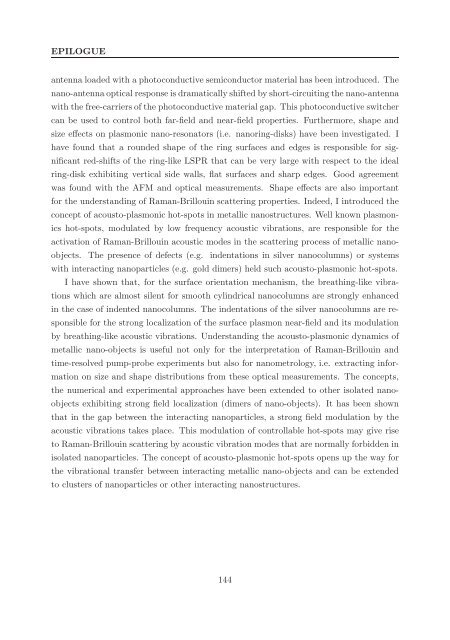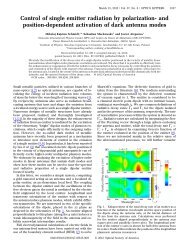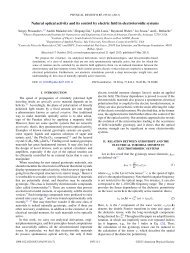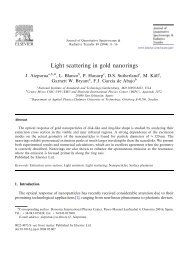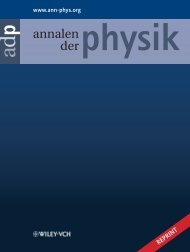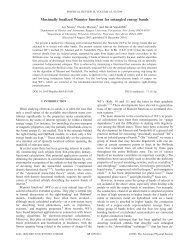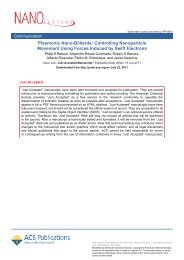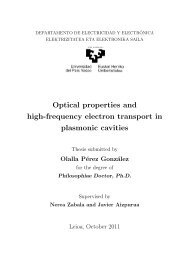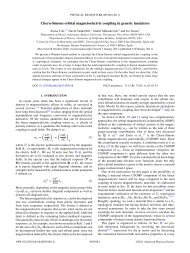Thesis Manuscript
Thesis Manuscript
Thesis Manuscript
You also want an ePaper? Increase the reach of your titles
YUMPU automatically turns print PDFs into web optimized ePapers that Google loves.
EPILOGUE<br />
antenna loaded with a photoconductive semiconductor material has been introduced. The<br />
nano-antenna optical response is dramatically shifted by short-circuiting the nano-antenna<br />
with the free-carriers of the photoconductive material gap. This photoconductive switcher<br />
can be used to control both far-field and near-field properties. Furthermore, shape and<br />
size effects on plasmonic nano-resonators (i.e. nanoring-disks) have been investigated. I<br />
have found that a rounded shape of the ring surfaces and edges is responsible for significant<br />
red-shifts of the ring-like LSPR that can be very large with respect to the ideal<br />
ring-disk exhibiting vertical side walls, flat surfaces and sharp edges. Good agreement<br />
was found with the AFM and optical measurements. Shape effects are also important<br />
for the understanding of Raman-Brillouin scattering properties. Indeed, I introduced the<br />
concept of acousto-plasmonic hot-spots in metallic nanostructures. Well known plasmonics<br />
hot-spots, modulated by low frequency acoustic vibrations, are responsible for the<br />
activation of Raman-Brillouin acoustic modes in the scattering process of metallic nanoobjects.<br />
The presence of defects (e.g. indentations in silver nanocolumns) or systems<br />
with interacting nanoparticles (e.g. gold dimers) held such acousto-plasmonic hot-spots.<br />
I have shown that, for the surface orientation mechanism, the breathing-like vibrations<br />
which are almost silent for smooth cylindrical nanocolumns are strongly enhanced<br />
in the case of indented nanocolumns. The indentations of the silver nanocolumns are responsible<br />
for the strong localization of the surface plasmon near-field and its modulation<br />
by breathing-like acoustic vibrations. Understanding the acousto-plasmonic dynamics of<br />
metallic nano-objects is useful not only for the interpretation of Raman-Brillouin and<br />
time-resolved pump-probe experiments but also for nanometrology, i.e. extracting information<br />
on size and shape distributions from these optical measurements. The concepts,<br />
the numerical and experimental approaches have been extended to other isolated nanoobjects<br />
exhibiting strong field localization (dimers of nano-objects). It has been shown<br />
that in the gap between the interacting nanoparticles, a strong field modulation by the<br />
acoustic vibrations takes place. This modulation of controllable hot-spots may give rise<br />
to Raman-Brillouin scattering by acoustic vibration modes that are normally forbidden in<br />
isolated nanoparticles. The concept of acousto-plasmonic hot-spots opens up the way for<br />
the vibrational transfer between interacting metallic nano-objects and can be extended<br />
to clusters of nanoparticles or other interacting nanostructures.<br />
144


